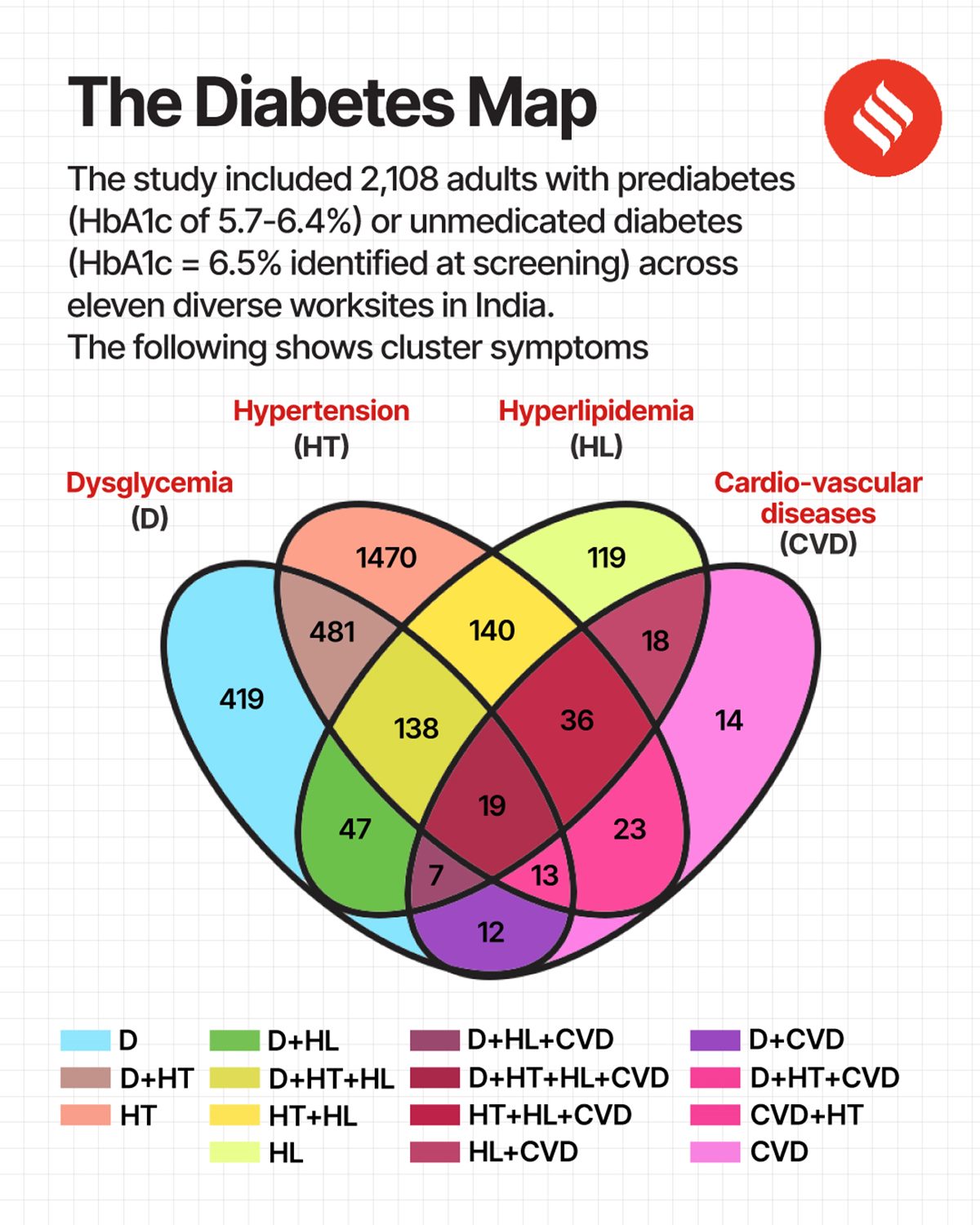Can changing portion sizes at the workplace canteen help you control and manage your blood sugar levels better? What if you could meet your daily quota of 30-minute physical activity with peers as part of group exercise sessions and brisk walks with your boss happily allowing the pen-down break? Workplace interventions and mindfulness can go a long way in helping us modify lifestyles even during a busy five-day week, according to the results of a programme conducted across 11 workplaces in five states by the Public Health Foundation of India (PHFI) and Madras Diabetes Research Foundation (MDRF) in collaboration with Emory and Harvard Universities.
The 18-month-long intervention, called INDIA WORKS or Integrating Diabetes Prevention in Workplaces, brought about a significant reduction in risk factors of diabetes among subjects. At least 25 per cent of the participants were able to achieve normal HbA1c (three-month average blood glucose) levels and even sustain them for about two years. The report is significant because it proposes a practical method of lifestyle solution. By effortlessly weaving in lifestyle corrections as corporate policy, the onus lessens on individuals to cram their weekend with guilty bouts of intense exercise. If we can increase physical activity to 150 minutes a week with moderate intensity activity such as brisk walking, we can lose at least seven per cent of baseline body weight if overweight or obese. And which employer wouldn’t want a more productive workforce?

“A structured lifestyle modification programme, improving food quality and encouraging healthy food choices at workplace canteens as well as increasing physical activity levels helped 547 of the 2,108 participants regress to a normal HbA1c – which is below 5.7 per cent,” says Dr V Mohan, President, Madras Diabetes Research Foundation and Chairman, Dr Mohan’s Diabetes Specialities Centre, Chennai. “Despite the disruptions caused by COVID-19, the levels held good for two years. Also, the systolic blood pressure dropped by 3 mm Hg, which can translate to a 15 per cent reduction in hypertension. Test participants further lost a kg of weight on average. At the population level, we observed 1.8 cm reduction in waist circumference,” he adds. The study can now serve as a work guide for Indian companies to implement healthy recommendations for their employees.
Story continues below this ad
India faces a burden of 101 million individuals living with diabetes, 136 million with pre-diabetes and 315 million individuals with hypertension. However, only a quarter of the rural and less than half of the urban population are aware that they live with these conditions. The role of the unique lifestyle intervention model is to prevent a further upsurge in diabetes and hypertension prevalence and the rapid progression from pre-diabetes to diabetes.
 The study included 2,108 adults with prediabetes (HbA1c of 5.7-6.4%) or unmedicated diabetes (HbA1c = 6.5% identified at screening) across eleven diverse worksites in India. (Designed by Abhishek Mitra)
The study included 2,108 adults with prediabetes (HbA1c of 5.7-6.4%) or unmedicated diabetes (HbA1c = 6.5% identified at screening) across eleven diverse worksites in India. (Designed by Abhishek Mitra)
The INDIA-WORKS research was conducted over a period of six years (2016-2022) and assessed crucial parameters like HbA1c, waist circumference, blood pressure, blood cholesterol and weight at 11 diverse work sites in five states — Kerala, Tamil Nadu, Jharkhand, Chhattisgarh, and Odisha. People were chosen from steel and manufacturing plants, locomotive units and refineries and comprised mostly industrial workers and managers, according to Dr Mohan.
Among the superbrand companies participating in the survey were Air India, Chennai, Ashok Leyland, Chennai, Bhilai and Bokaro steel plants and HLL Lifecare, Thiruvananthapuram and TVS Lucas, Chennai.
While a total of 6,265 employees were screened, researchers noted that obesity was prevalent in nine of 10 participants screened. Which means nearly half of those screened were at a high risk of developing diabetes and one in three reported hypertension. That’s why only 2,108 employees could be eligible for intervention. The average age of participants was 46, 77 percent being predominantly men.
“This is one of the longest-surveyed reports in the corporate world and now participating worksites have a template for creating healthier workplaces. They are also great examples of how management and employees can work together to prevent disease among workers and their families by making simple, practical and sustainable lifestyle changes at the workspace,” Dr Mohan adds.
Story continues below this ad
The worksite-based lifestyle intervention model focussed on programme effectiveness and success of implementation (e.g., feasibility, acceptability, and sustainability. Employees also worked with trained peer educators from worksites to deliver the intervention. The model included weekly classes for the first few months and monthly classes for the remaining eight months.
“Organised sector (large or medium-sized industries or offices) employees have the highest burden of chronic disease risk factors such as obesity, diabetes and hypertension. There is substantial evidence that we can prevent or control these risk factors if people have acquired these diseases already. The INDIA-WORKS programme demonstrates average reduction in cardiometabolic risk factors such as weight, waist circumference, blood pressure, and HbA1c,” says Dr D Prabhakaran, Executive Director, of Centre for Chronic Disease Control, and Distinguished Professor at the Public Health Foundation of India (PHFI). “The risk of diabetes is four and a half times less when one is able to reduce his/her weight by 5 kg. With minor adjustments in employees’ diet coupled with a daily brisk walking capsule of 30 minutes for five days a week, the workplace health programme can be a gamechanger,” he adds.
Diabetes in India: Need to knows
• Exponential upsurge in the prevalence in the past two decades.
• Poor awareness of the condition.
• Only a quarter of rural and less than half of the urban individuals with diabetes are aware of their condition.
• Diabetes risk escalates in early adulthood and often results in increase in life-time exposure to diabetes.
Implications
• Increased risk of macrovascular (large arteries) complications such as heart attacks and strokes.
• Increased risk for microvascular (Small arteries) complications such as kidney failure, vision loss due to retinopathy, nerve damage, and amputation.
• High treatment costs, which overstretches the healthcare system.
• Increased out of pocket expenditure, and catastrophic health expenditure in families.
• Huge productivity loss attributable to absenteeism, presenteeism and burden on caregiving.
• Poor quality of life.



 The study included 2,108 adults with prediabetes (HbA1c of 5.7-6.4%) or unmedicated diabetes (HbA1c = 6.5% identified at screening) across eleven diverse worksites in India. (Designed by Abhishek Mitra)
The study included 2,108 adults with prediabetes (HbA1c of 5.7-6.4%) or unmedicated diabetes (HbA1c = 6.5% identified at screening) across eleven diverse worksites in India. (Designed by Abhishek Mitra)





























